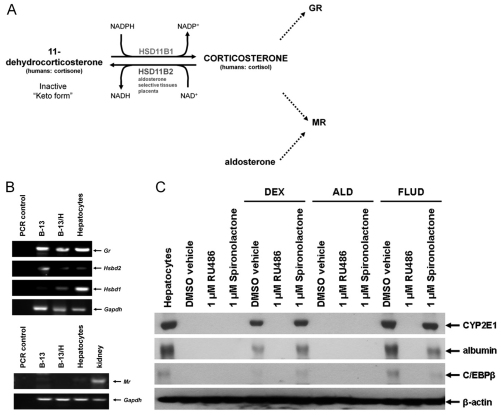Fig. 1.
Transdifferentiation of B-13 cells into B-13/H cells is dependent on glucocorticoid interaction with the glucocorticoid receptor, not the mineralocorticoid receptor. (A) schematic diagram of glucocorticoid metabolism and interaction with the GR and MR. In aldosterone-selective tissues such as the kidney and placenta, 11β-hydroxysteroid dehydrogenase 2 (HSD11B2) oxidises glucocorticoids to an inactive keto form, reducing glucocorticoid activation of the MR. In tissues such as the liver, 11β-hydroxysteroid dehydrogenase 1 (HSD11B1) promotes high concentrations of active glucocorticoid, ensuring these tissue are responsive to circulating glucocorticoid levels. (B) RT-PCR analysis of the expression of the indicated transcript using primers listed in Table 1. (C) Western blot showing the expression of the indicated liver markers plus β-actin as loading control. B-13 cells were cultured with the indicated additions made from 1000-fold ethanol stocks. Control cells received 0.1% (v/v) ethanol. Medium and additions were renewed every 2–3 days and cells were harvested for western blotting analysis (30 μg total protein/lane) after 14 days of treatment. FLUD, fludrocortisone; ALD, aldosterone. All data are typical of at least three separate experiments.

